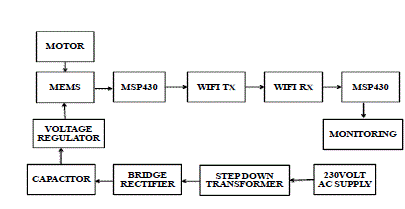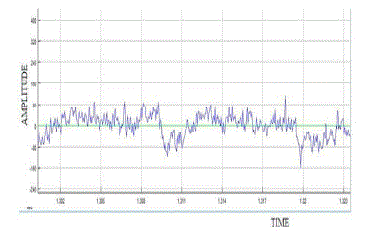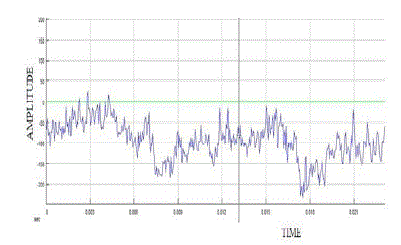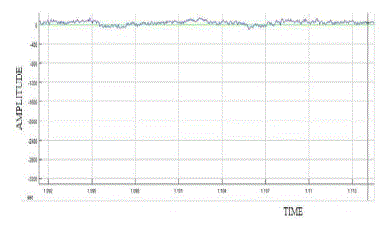Keywords
|
| Microelectro Mechanical system,Wavelet Tranformation |
INTRODUCTION
|
| Drives are a critical component of many industrial application processes and are frequently integrated in commercially available equipment and industrial processes. Motor-driven equipment often provide core capabilities essential to business success and to safety of equipment and personnel. There are many published techniques and many commercially available tools to monitor drives to insure a high degree of reliability uptime. In spite of these tools, many companies are still faced with unexpected system failures and reduced motor lifetime. Environmental, duty, and installation issues may combine to accelerate motor failure far sooner than the designed motor lifetimes. Critical induction motor applications are found in all industries and include all motor horsepower’s. It have been found that many of the commercial products to monitor drives are not cost effective Advances in sensors, algorithms, and architectures should provide the necessary technologies for effective incipient failure detection. The new technique using MEMS has been implemented to diagnose the fault. Objective of our project is to monitor the fault through vibrations of a drives and to overcome the problems, by implementing a new platform for monitoring the faults using MEMS. |
FAULTS IN DRIVES
|
| The Faults that are detected by using MEMS under Three Conditions. The Conditions are |
| 1. Under Low Speed |
| 2. Under Transient Condition |
| 3. Under High Speed |
DIAGNOSTIC METHODS TO DETECT FAULTS
|
| Diagnostic Methods to detect faults are Electromagnetic field monitoring, Temperature measurements, RF emission monitoring, Noise & vibration monitoring, Motor Current Signature Analysis (MCSA), AI & NN based techniques. The signal processing tools include DFT, FFT, STFT and Wavelet transform. Artificial intelligence is also used for fault diagnosis .These techniques include the applications of expert systems, genetic algorithm, neural networks and fuzzy logic. Modern techniques are based on application of advanced DSP tools on stator currents for fault diagnosis i.e. MCSA. Faults can be diagnosed using any one of signal processing techniques. These signal processing techniques cannot be used for diagnosing every type of faults. There is need to compare and analyze various signal processing techniques for diagnosing a particular fault to identify most congruous technique for particular fault. |
| a. Fault Diagnosis In Motors |
| • When the fault happens, the motor can be operated without breakdown, but it is necessary to maintain the motor for continuous working. Several methods have been applied to detect faults. It is important to be able to detect faults while they are still developing. This is called incipient failure detection. |
| Timely warning that can be followed by maintenance can avoid catastrophic failures & costly long down times. The incipient detection of failures also results in a safer operating environment. Faults can occur either in stator, rotor, inverter or in the external systems connected to the motor. |
| • Vibration monitoring is the most popular choice for condition monitoring but it is preferred for use only in large machines where expensive accelerometers can be afforded. |
| • Electrical monitoring, which includes current based monitoring, is the most recent of all condition monitoring techniques and is inexpensive as electrical sensors are lower in cost compared to mechanical transducers. |
| • Condition monitoring is defined as the continuous evaluation of the health of the plant and equipment throughout its service life. It is used to detect various types of faults such as rotor fault, short winding fault, air gap eccentricity fault, bearing fault, load fault etc. |
| • Current monitoring does not require additional sensors because basic electrical quantities associated with electromechanical plants such as current & voltage are readily measured by tapping into existing voltage & current transformers that are always installed as part of protection system. It is non intrusive & implemented in motor control centre remotely from the motors being monitored. |
| b. Methods For Current Monitoring |
| • Methods for current monitoring are MCSA (Motor Current Signature Analysis) & Park Vector approach. MCSA uses the current spectrum of machine for locating characteristic fault frequencies. When a fault is present, the frequency spectrum of the line current becomes different from healthy motor. Such fault modulates air gap & produces rotating frequency harmonics in the self & mutual inductances of machine. |
SIGNAL PROCESSING TECHNIQUES
|
| Different algorithms are proposed to track & detect the faults operating under different load conditions: Fast Fourier Transform, Short time Fourier Transform, Wavelet Transform, Gabor Transform, Park’s Vector approach, Wigner Ville distribution, Short time Fourier Transform and MCSA. The condition monitoring techniques utilised the spectral analysis of motor current or voltage. |
| A. Fast Fourier Transform (FFT). FFT is employed for the extraction of frequency contents in signal, in order to detect stator and rotor faults in BLDC motor. A fault in motor by FFT can be detected easily in comparison to time domain analysis. FFT is simply a computationally efficient way to calculate the Discrete Fourier Transform (DFT) which is calculated as |
 (1) (1) |
| Where X(k) − Fourier transform of the signal |
| k − frequency index |
| n − time index |
| NâÃâÃ⬠total length of the signal |
| The specific characteristic fault frequency can be easily & accurately diagnosed using FFT with the loss of time information. |
| B. Short Time Fourier Transform ( STFT ) |
| STFT is used to analyse signal in both time and frequency domain. In this, original signal is divided into small segments and each segment is multiplied with shifted window function of a chosen width in order to produce short stationary signals. This process is defined by: |
 (2) (2) |
| X(τ,w)− short time Fourier transform of the current signal i(t) |
| w = 2πf, where f is the frequency of the signal |
| W(t-τ) − window function |
| t − time |
| τ − delay parameter |
| τ − delay parameter The drawback of this technique is that particular size for time window, is same for all frequencies. But many signals require variable window size. |
| c. Wavelet analysis The wavelet analysis confines signals information in the time frequency plane and makes it suitable for the analysis of non- stationary signals. It is a substitute to the STFT analysis. The general Wavelet transform of a signal is defined by: |
 (3) (3) |
| Where WT – wavelet transform of the current signal, i (t) |
| φ ,τ − wavelet function |
| a and τ – scaling and translation respectively |
| *denotes the complex conjugate of the function |
| Wavelet analysis allows use of both long time intervals requiring more precise low frequency information and short time intervals requiring high frequency information. But this analysis has disadvantage of using large no of scales for calculations. |
| d .MEMS |
| Advance detection of faults in drives using MEMS has been analyzed. The Faults in the drives detected once that occurred in the system. So, the motors are prevented before it get damaged. Objective is to pre-analyze the faults in drives by using vibration monitoring technique. This technique was utilized for incipient fault detection by placing accelerometers at the shell of the machine. By using the Vibration monitoring technique the faults in the drives will be analysed. A single phase Induction motor used for implementation where MEMS mounted over the shell of the motor. |
SIMULATION OF STUDIES
|
| The output has been implemented by using simulation, through M File. An m-file, or script file, is a simple text file where you can place MATLAB commands. When the file is run, MATLAB reads the commands and executes them exactly as it would if you had typed each command sequentially at the MATLAB prompt. All m-file names must end with the extension '.m' (e.g. test.m). If you create a new m-file with the same name as an existing m-file, MATLAB will choose the one which appears first in the path order (type help path in the command window for more information). To make life easier, choose a name for your m-file which doesn't already exist. To see if a file name.m already exists, type help filename at the MATLAB prompt. |
| The amplitude of the vibration level is high when too much of load has been applied to the motor. The amplitude of the plotted graph measures more or less 85. |
| This waveforms shows the unbalanced condition of the motor using the MEMS accelerometer. The vibration signals have been captured and processed using wavelet transform and plotted as graph. Here changes in amplitude indicate the vibration level of the motor. |
| This waveform indicates the sudden rise and fall in the amplitude of the signal represents the rotor fault in the motor. This is caused because of sudden increase in speed and sudden drop in speed due to rotor bend or damage. The amplitude of the plotted graph changes. |
| The vibration level of the motor will be normal state when load applied to the motor is in valid amount. The amplitude will be more or less 20. This waveforms show the unbalanced condition of the motor using the MEMS accelerometer. The vibration signals have been captured and processed using wavelet transform and plotted as graph. Here changes in amplitude indicate the vibration level of the motor. Greater the amplitude changes vibration level is high; lesser the amplitude indicates the normal state of the motor. |
CONCLUSION
|
| One of the most serious problems in Industrial Motor’s is the possibility of mechanical failure, especially for rotating parts of gears and generators. Therefore, a machine health monitoring system is a very important tool in Industrial Motor’s. Moreover, wireless sensor technologies make it possible to measure and control the vibrations of the machine during operation. The methods of mechanical fault detection through vibration analysis have been analysed and assessed based on their ability to detect machine abnormalities. By using an MEMS accelerometer which is low cost, light in weight, compact in size and low in power consumption, a vibration detection method is proposed in this dissertation. Machine vibration analysis in time and frequency domain has been analysed and a severity detection technique is also established. These are the essential components for an advance health monitoring system. The implementation of mechanical fault monitoring system can be used to estimate the range of severity levels, which makes it possible to detect the abnormalities before failure. It is very useful part of the condition based predictive maintenance. This control technique works well both under the normal and disturbance operation. This enhancement of the vibration suppression capabilities opens up the possibility of improving the performance of the windmill. This will greatly improve the power quality and reduce the downtime when there is wear and tear on the mechanical components, such as shaft, gear box, and rotating parts. |
| |
Figures at a glance
|
 |
 |
 |
 |
| Figure 1 |
Figure 2 |
Figure 3 |
Figure 4 |
|
| |
References
|
- Bellini.A , Filippetti.F, Tassoni.C, and Capolino G. A.( 2008) ‘Advances in i-agnostic techniques for induction machines’ IEEE Trans. Ind. Electron. vol. 55, no. 12, pp. 4109–4126.
- 2.Chen. S and Zivanovic .R (2010) ‘Estimation of frequency components in stator current for the detection of broken rotor bars in induction machines’ Measurement, vol. 43, no. 7, pp. 887–900.
- Cheng.S, Zhang.P, and Habetler.T.G (2011)’An impedance identification approach to sensitive detection and location of stator turn-to-turn faults in a closed-loop multiple-motor drive’ IEEE Trans. Ind. Electron., vol. 58, no. 5, pp. 1545–1554.
- Derek K. Shaeffer, InvenSense, Inc.(2013)’ MEMS Inertial Sensors,A Tutorial Overview’ IEEE Trans. Ind. Electron., vol. 58, no. 5, pp. 1545– 1554.
- El Hachemi Benbouzid.M.(2000)’A review of induction motors signature analysis as a medium for faults detection’ IEEE Trans. Ind. Electron.,vol. 47, no. 5, pp. 984–9
- Giacomo Langfelder, Cesare Buffa, Attilio Frangi, Alessandro Tocchio, Ernesto Lasalandra, and Antonio Longoni (2013)’ Z-Axis Magnetometers for MEMS Inertial Measurement Units Using an Industrial Process’IEEE Trans . Ind. Electron.,Vol.60,no.9
- Hsu J. S (1995) ‘Monitoring of defects in induction motors through air-gap torque observation’ IEEE Trans. Ind. Appl., vol. 31, no. 5, pp. 1016– 1021.
- Ioannis ZeimJpekis, Ibrahim Sari, and Michael Kraft(2012)’ Characterization of a Mechanical Motion Amplifier Applied to a MEMS Accelerometer’ journal of Microelectro mechanical system,Vol.21,no.5
- Joksimovic.G.M and Penman.J(2000)’The detection of inter-turn short circuits in the stator windings of operating motors’ IEEE Trans. Ind. Electron., vol. 47, no. 5, pp. 1078–1084.
- JoksimMovic. G.M, Durovic M. D, Penman J, and Arthur.N (2000)’Dynamic simulation of dynamic eccentricity in induction machineswinding function approach,” IEEE Trans. Energy Convers., vol. 15, no. 2, pp. 143–148.
- Joksimovic.G.M (2005)’Dynamic simulation of cage induction machine with air gap eccentricity’ Proc. Inst. Elect. Eng.—Elect. Power Appl., vol. 152, no. 4, pp. 803–811, Jul. 2005.
- .Kazem Zandi, Joseph André Bélanger, and Yves-Alain Peter(2012)’ Design and Demonstration of an In-Plane Silicon-on-Insulator Optical MEMS Fabry–Pérot-Based Accelerometer Integrated With Channel Waveguides’IEEE journal Vol.21,no.6.
- Nandi.S, Bharadwaj. R. M., and Toliyat.H.A,(2002)Performance analysis of a three-phase induction motor under mixed eccentricity condition,” IEEE Trans. Energy Convers., vol. 17, no. 3, pp. 392–399.
- 14.Nandi.S, Toliyat H. A, and Xiaodong.L,(2005) ‘Condition monitoring and fault diagnosis of electrical motors A review’ IEEE Trans. Energy Convers.,vol. 20, no. 4, pp. 719–729
- Nandi .S, Ilamparithi T. C, Bin L. S., and Doosoo.H ,’Detection of eccentricity faults in induction machines based on nameplate parameters,” IEEE Trans. Ind. Electron., vol. 58, no. 5, pp. 1673–1683.
- Osman Aydin and Tayfun Akin (2013)’ A Bulk-Micromachined Fully Differential MEMS Accelerometer With Split Interdigitated Fingers’IEEE sensors journal.,Vol.13,no.8
- Riera-Guasp.M, Antonino-Daviu.J.A, Roger-Folch.J, and Molina Palomares M.P (2008) ‘The use of the wavelet approximation.
- Ruize Xu, Shengli Zhou, and Wen J(2012)’ MEMS Accelerometer Based Nonspecific-User Hand Gesture Recognition’ IEEE sensor journal,vol .12,no.5
- Schoen.R.R and Habetler.T.G (1995)’Effects of time-varying loads on rotor fault detection in induction machines’ IEEE Trans. Ind. Appl., vol. 31, no. 4, pp. 900–906.
- Wolbank.T.W , Nussbaumer.P, Hao.C, and Macheiner.P.E (2011)’Monitoring of rotor-bar defects in inverter-fed induction machines at zero load and speed’ IEEE Trans. Ind. Electron., vol. 58, no. 5, pp. 1468–1478.
- Xianrong.C, Cocquempot, and Christophe.C (2003)’A model of asynchronous machines for stator fault detection and isolation’IEEE Trans. Ind. Electron., vol. 50, no. 3, pp. 578–584.
- Zidani.F, Benbouzid.M.E.H, Diallo.D, and Nait-Said.M.S (2011)’Induction motor stator faults diagnosis by a current Concordia pattern-based fuzzy decision system,” EEE Trans. Energy Convers., vol. 18, no. 4, pp. 469–475.
|